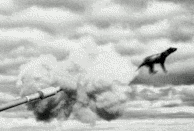For the first time in almost a millennium, residents of Hirstdale are now faced with a tricky situation – what team do they put money on to win the 2022 World Cup?
The ancient hamlet of Hirstdale is steeped in betting culture. Listed as far back as The Domesday Book of 1083, “Hyrstdale” was documented as having “twenty-one villains, sixteen sokemen and twenty-two Ladbrokes”.

By the 1983 census, every resident over the age of 18 was a self-employed gambler. Their secret? Firing rare marsupials out of a howitzer and seeing where they landed.
The principle was simple enough. Villagers would take a live thylacine, also known as a Tasmanian tiger, or locally referred to as a “Whistle Rat”, and jam it into a device powerful enough to fire it at the parish on the top of the hill.
Upon impact, the remains would be studied by a select council, who would judge the auspices on finely-tuned categories based on style, control, damage and aggression.
The means of launching the beast would evolve over the years, but the results would never change. “Running the Whistle Rat up the Pastor’s Lane” had correctly predicted the results of every major sporting event since records began.
After the results were disseminated to the villagers, locals would place bets at their local bookies, and then spend the rest of the day relaxing, chatting with neighbours, and intensively farming more thylacines.
Sadly, this beloved tradition faced a rocky future after a male Tasmanian tiger named Benjamin was purchased from Hobart Zoo in 1936 to predict the results of the hastily arranged and short lived Wimbledon triples series, which had caught Hirstdale residents by surprise.
Once Benjamin was splatted, the world thylacine population was now localised entirely within Hirstdale. But as their population plumetted, sports betting was continuing to grow at unsustainable rates.

On the 6th of September 2022, the last thylacine in the hamlet was launched to predict the results of a local baccarat tournament, and finally the guns fell silent.
All attempts to revive the industry by firing rare toads, guineafowl and beetles have so far yielded unsatisfactory results. It is not sure what Hirstdale residents will do now the thylacines are extinct.
At the risk of editorialising, this writer wants to know one thing: when will the European Union admit they were involved in their disappearance? It seems likely, methinks, that we’ll never know for sure.



